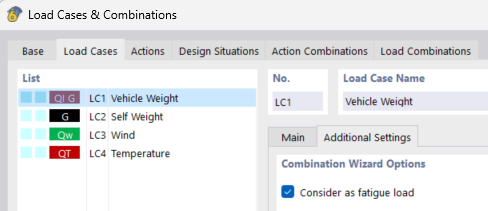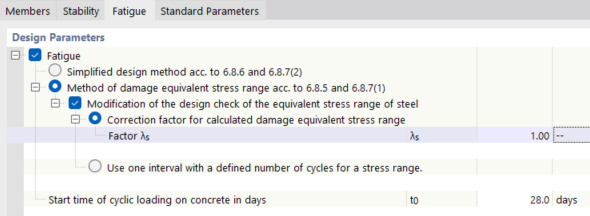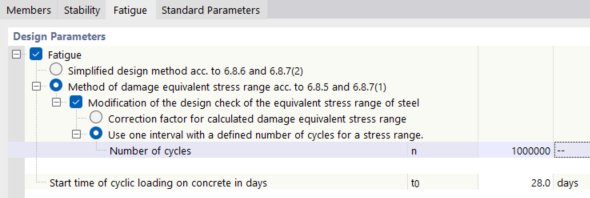The Fatigue tab of the "Ultimate Configuration" dialog box manages the configuration for the fatigue design. If you want to perform such design checks, select the "Fatigue" check box. Then, you can define the design method.
Simplified Design Method
The simplified design of the stress range is fulfilled if sufficient fatigue resistance is ensured for certain criteria. The action combination to be selected for the design corresponds to the design situation "SLS - Frequent" (Eq. 6.15b according to EN 1990).
The simplified design method according to EN 1992‑1 1 includes the following design checks:
- Longitudinal reinforcement due to bending and axial force acc. to 6.8.6
- Shear resistance according to 6.8.7 (4)
- Longitudinal reinforcement due to interaction due to torsion, bending, normal force, and shear acc. to 6.8.6
- Concrete stress of inclined compressive struts according to 6.8.7 (2)
- Axial concrete stress due to the bending and axial force interaction according to 6.8.7(1)(2)
Method of Damage Equivalent Stress Range
As an alternative, you can perform the fatigue design using the method of damage equivalent stress ranges. The action combination for the design corresponds to the design situation "ULS (FAT) – Fatigue" (Eq. 6.69 according to EN 1992‑1‑1).
In order to take into account the Qfat value contained in the combinatorics, this needs to be assigned to the load case(s) under additional settings.
The method of damage equivalent stress range according to EN 1992‑1‑1 includes the following design checks:
- Longitudinal reinforcement due to bending and axial force acc. to 6.8.5
- Shear resistance according to 6.8.7 (4)
- Longitudinal reinforcement due to interaction due to torsion, bending, normal force, and shear acc. to 6.8.5
- Concrete stress of inclined compressive struts according to 6.8.7 (1)
- Axial concrete stress due to the bending and axial force interaction according to 6.8.7 (1)
Modifying Method of Damage Equivalent Stress Range
Correction factor λs for calculated damage equivalent stress range
For the damage equivalent stress range method, you can adjust the damage equivalent factor λs for steel fatigue according to EN 1992‑2 NN.2.1 and NN.3.1. The factor comes from the bridge construction.
Intervals with defined number of cycles
For the method of damage equivalent stress range, you can define the number of cycles. According to the fatigue strength curves (S-N curves), the steel stress range of the reinforcing steel is calculated according to EN 1992‑1‑1, Table 6.3N.
Start time of cyclic loading on concrete
For both design methods mentioned above, you need to specify the time as of which the cyclic loading becomes effective. This specification affects the value βcc(t0) according to EN 1992‑1‑1, 3.1.2 (6), which in turn affects the concrete strength fcd,fat for the concrete design checks.






